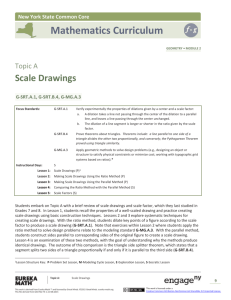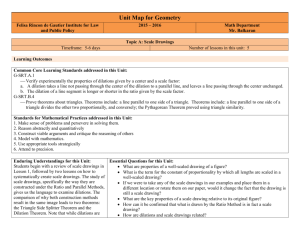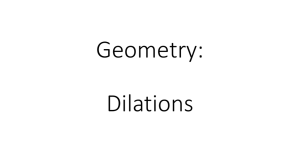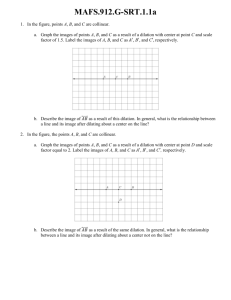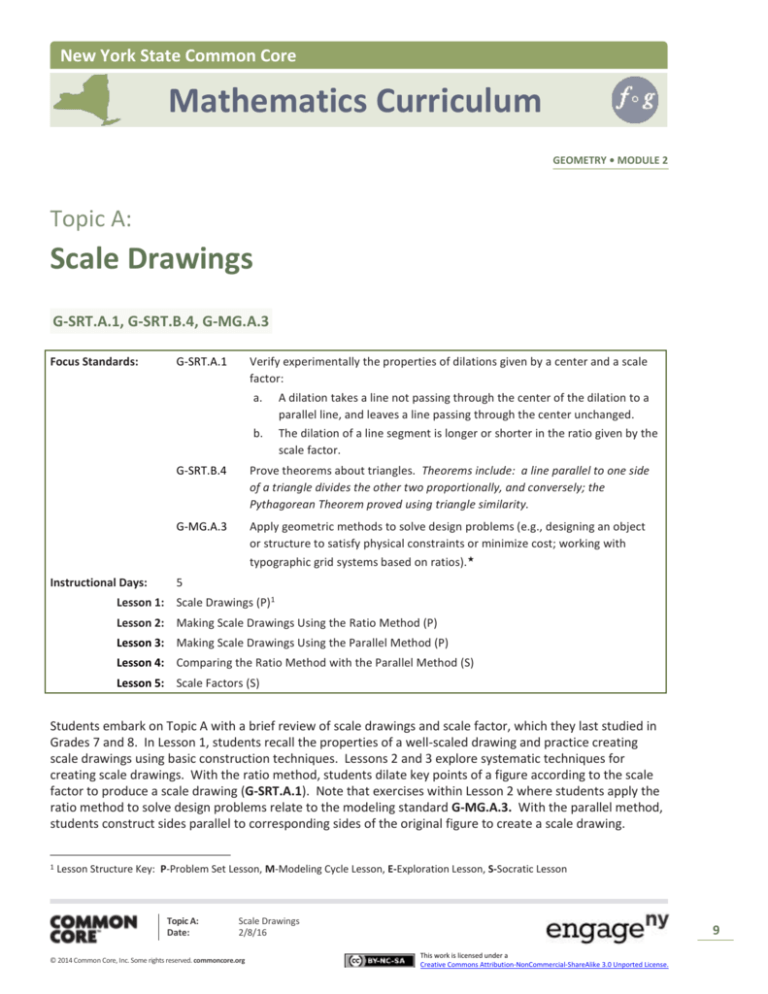
New York State Common Core
Mathematics Curriculum
GEOMETRY • MODULE 2
Topic A:
Scale Drawings
G-SRT.A.1, G-SRT.B.4, G-MG.A.3
Focus Standards:
Instructional Days:
G-SRT.A.1
Verify experimentally the properties of dilations given by a center and a scale
factor:
a.
A dilation takes a line not passing through the center of the dilation to a
parallel line, and leaves a line passing through the center unchanged.
b.
The dilation of a line segment is longer or shorter in the ratio given by the
scale factor.
G-SRT.B.4
Prove theorems about triangles. Theorems include: a line parallel to one side
of a triangle divides the other two proportionally, and conversely; the
Pythagorean Theorem proved using triangle similarity.
G-MG.A.3
Apply geometric methods to solve design problems (e.g., designing an object
or structure to satisfy physical constraints or minimize cost; working with
typographic grid systems based on ratios). ★
5
Lesson 1: Scale Drawings (P)1
Lesson 2: Making Scale Drawings Using the Ratio Method (P)
Lesson 3: Making Scale Drawings Using the Parallel Method (P)
Lesson 4: Comparing the Ratio Method with the Parallel Method (S)
Lesson 5: Scale Factors (S)
Students embark on Topic A with a brief review of scale drawings and scale factor, which they last studied in
Grades 7 and 8. In Lesson 1, students recall the properties of a well-scaled drawing and practice creating
scale drawings using basic construction techniques. Lessons 2 and 3 explore systematic techniques for
creating scale drawings. With the ratio method, students dilate key points of a figure according to the scale
factor to produce a scale drawing (G-SRT.A.1). Note that exercises within Lesson 2 where students apply the
ratio method to solve design problems relate to the modeling standard G-MG.A.3. With the parallel method,
students construct sides parallel to corresponding sides of the original figure to create a scale drawing.
1
Lesson Structure Key: P-Problem Set Lesson, M-Modeling Cycle Lesson, E-Exploration Lesson, S-Socratic Lesson
Topic A:
Date:
Scale Drawings
2/8/16
© 2014 Common Core, Inc. Some rights reserved. commoncore.org
9
This work is licensed under a
Creative Commons Attribution-NonCommercial-ShareAlike 3.0 Unported License.
NYS COMMON CORE MATHEMATICS CURRICULUM
Topic A
M2
GEOMETRY
Lesson 4 is an examination of these two methods, with the goal of understanding why the methods produce
identical drawings. The outcome of this comparison is the triangle side splitter theorem, which states that a
segment splits two sides of a triangle proportionally if and only if it is parallel to the third side (G-SRT.B.4).
This theorem is then used in Lesson 5 to establish the dilation theorem: A dilation from a center 𝑂 maps a
⃡ and
segment 𝑃𝑄 to a segment 𝑃′𝑄′ so that 𝑃′ 𝑄 ′ = 𝑟 ⋅ 𝑃𝑄; additionally, if 𝑂 is not contained in the line 𝑃𝑄
⃡ ′ 𝑄 ′.
⃡ ||𝑃
𝑟 ≠ 1, then 𝑃𝑄
As opposed to work done in Grade 8 on dilations, where students observed how dilations behaved and
experimentally verified properties of dilations by examples, high school Geometry is anchored in explaining
why these properties are true by reasoned argument. Grade 8 content focused on what was going on, high
school Geometry content focuses on explaining why it occurs. This is particularly true in Lessons 4 and 5,
where students rigorously explain their explorations of dilations using the ratio and parallel methods to build
arguments that establish the triangle side splitter and dilation theorems (MP.3).
Topic A:
Date:
Scale Drawings
2/8/16
© 2014 Common Core, Inc. Some rights reserved. commoncore.org
10
This work is licensed under a
Creative Commons Attribution-NonCommercial-ShareAlike 3.0 Unported License.

